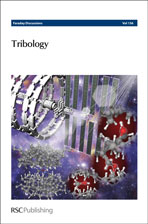3-((1H-benzo[d][1,2,3]triazol-1-yl)methyl)-1-methyl-1H–imidazolium hexafluorophosphates ([BTAMIM][PF6]) ionic liquids (ILs) were evaluated as friction reduction, antiwear (AW) and anticorrosion additives in poly(ethylene glycol) (PEG) for steel/Cu–Sn alloy contacts at 100 °C. The physical properties of PEG with the additive were measured. The anticorrosion properties of [BTAMIM][PF6] was assessed via the accelerated corrosion test, which reveals the excellent anticorrosion properties in comparison with selected conventional ILs that have no benzotriazole group. Tribological results indicated that [BTAMIM][PF6] as additives could effectively reduce the friction and wear of sliding pairs in PEG. The tribological properties were generally better than the normally used dibutyl phosphite (T304) and conventional ILs L-P108 in PEG. The wear mechanisms are tentatively discussed according to the morphology observation of worn surfaces of Cu–Sn alloy discs by scanning electron microscopy (SEM) and surface composition analysis by X-ray photoelectron spectroscopy (XPS), which revealed complex tribochemical reactions during the sliding process leading to a surface protective film composed of [Cu(–C6H5N3-R)], Cu2O, CuF2 and C–O bond containing compound is formed. A strong interaction between benzotriazole and the surface of the Cu alloy was proposed to account for the excellent friction reduction, anti-wear and anti-corrosion capability improvement.
You have access to this article
 Please wait while we load your content...
Something went wrong. Try again?
Please wait while we load your content...
Something went wrong. Try again?

 Please wait while we load your content...
Please wait while we load your content...